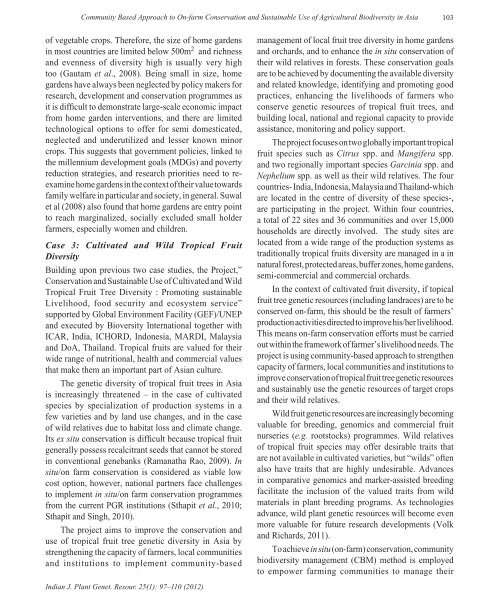indian society of plant genetic resources - Bioversity International
indian society of plant genetic resources - Bioversity International
indian society of plant genetic resources - Bioversity International
Create successful ePaper yourself
Turn your PDF publications into a flip-book with our unique Google optimized e-Paper software.
Community Based Approach to On-farm Conservation and Sustainable Use <strong>of</strong> Agricultural Biodiversity in Asia 103<br />
<strong>of</strong> vegetable crops. Therefore, the size <strong>of</strong> home gardens<br />
in most countries are limited below 500m 2 and richness<br />
and evenness <strong>of</strong> diversity high is usually very high<br />
too (Gautam et al., 2008). Being small in size, home<br />
gardens have always been neglected by policy makers for<br />
research, development and conservation programmes as<br />
it is diffi cult to demonstrate large-scale economic impact<br />
from home garden interventions, and there are limited<br />
technological options to <strong>of</strong>fer for semi domesticated,<br />
neglected and underutilized and lesser known minor<br />
crops. This suggests that government policies, linked to<br />
the millennium development goals (MDGs) and poverty<br />
reduction strategies, and research priorities need to reexamine<br />
home gardens in the context <strong>of</strong> their value towards<br />
family welfare in particular and <strong>society</strong>, in general. Suwal<br />
et al (2008) also found that home gardens are entry point<br />
to reach marginalized, socially excluded small holder<br />
farmers, especially women and children.<br />
Case 3: Cultivated and Wild Tropical Fruit<br />
Diversity<br />
Building upon previous two case studies, the Project,”<br />
Conservation and Sustainable Use <strong>of</strong> Cultivated and Wild<br />
Tropical Fruit Tree Diversity : Promoting sustainable<br />
Livelihood, food security and ecosystem service”<br />
supported by Global Environment Facility (GEF)/UNEP<br />
and executed by <strong>Bioversity</strong> <strong>International</strong> together with<br />
ICAR, India, ICHORD, Indonesia, MARDI, Malaysia<br />
and DoA, Thailand. Tropical fruits are valued for their<br />
wide range <strong>of</strong> nutritional, health and commercial values<br />
that make them an important part <strong>of</strong> Asian culture.<br />
The <strong>genetic</strong> diversity <strong>of</strong> tropical fruit trees in Asia<br />
is increasingly threatened – in the case <strong>of</strong> cultivated<br />
species by specialization <strong>of</strong> production systems in a<br />
few varieties and by land use changes, and in the case<br />
<strong>of</strong> wild relatives due to habitat loss and climate change.<br />
Its ex situ conservation is diffi cult because tropical fruit<br />
generally possess recalcitrant seeds that cannot be stored<br />
in conventional genebanks (Ramanatha Rao, 2009). In<br />
situ/on farm conservation is considered as viable low<br />
cost option, however, national partners face challenges<br />
to implement in situ/on farm conservation programmes<br />
from the current PGR institutions (Sthapit et al., 2010;<br />
Sthapit and Singh, 2010).<br />
The project aims to improve the conservation and<br />
use <strong>of</strong> tropical fruit tree <strong>genetic</strong> diversity in Asia by<br />
strengthening the capacity <strong>of</strong> farmers, local communities<br />
and institutions to implement community-based<br />
Indian J. Plant Genet. Resour. 25(1): 97–110 (2012)<br />
management <strong>of</strong> local fruit tree diversity in home gardens<br />
and orchards, and to enhance the in situ conservation <strong>of</strong><br />
their wild relatives in forests. These conservation goals<br />
are to be achieved by documenting the available diversity<br />
and related knowledge, identifying and promoting good<br />
practices, enhancing the livelihoods <strong>of</strong> farmers who<br />
conserve <strong>genetic</strong> <strong>resources</strong> <strong>of</strong> tropical fruit trees, and<br />
building local, national and regional capacity to provide<br />
assistance, monitoring and policy support.<br />
The project focuses on two globally important tropical<br />
fruit species such as Citrus spp. and Mangifera spp.<br />
and two regionally important species Garcinia spp. and<br />
Nephelium spp. as well as their wild relatives. The four<br />
countries- India, Indonesia, Malaysia and Thailand-which<br />
are located in the centre <strong>of</strong> diversity <strong>of</strong> these species-,<br />
are participating in the project. Within four countries,<br />
a total <strong>of</strong> 22 sites and 36 communities and over 15,000<br />
households are directly involved. The study sites are<br />
located from a wide range <strong>of</strong> the production systems as<br />
traditionally tropical fruits diversity are managed in a in<br />
natural forest, protected areas, buffer zones, home gardens,<br />
semi-commercial and commercial orchards.<br />
In the context <strong>of</strong> cultivated fruit diversity, if topical<br />
fruit tree <strong>genetic</strong> <strong>resources</strong> (including landraces) are to be<br />
conserved on-farm, this should be the result <strong>of</strong> farmers’<br />
production activities directed to improve his/her livelihood.<br />
This means on-farm conservation efforts must be carried<br />
out within the framework <strong>of</strong> farmer’s livelihood needs. The<br />
project is using community-based approach to strengthen<br />
capacity <strong>of</strong> farmers, local communities and institutions to<br />
improve conservation <strong>of</strong> tropical fruit tree <strong>genetic</strong> <strong>resources</strong><br />
and sustainably use the <strong>genetic</strong> <strong>resources</strong> <strong>of</strong> target crops<br />
and their wild relatives.<br />
Wild fruit <strong>genetic</strong> <strong>resources</strong> are increasingly becoming<br />
valuable for breeding, genomics and commercial fruit<br />
nurseries (e.g. rootstocks) programmes. Wild relatives<br />
<strong>of</strong> tropical fruit species may <strong>of</strong>fer desirable traits that<br />
are not available in cultivated varieties, but “wilds” <strong>of</strong>ten<br />
also have traits that are highly undesirable. Advances<br />
in comparative genomics and marker-assisted breeding<br />
facilitate the inclusion <strong>of</strong> the valued traits from wild<br />
materials in <strong>plant</strong> breeding programs. As technologies<br />
advance, wild <strong>plant</strong> <strong>genetic</strong> <strong>resources</strong> will become even<br />
more valuable for future research developments (Volk<br />
and Richards, 2011).<br />
To achieve in situ (on-farm) conservation, community<br />
biodiversity management (CBM) method is employed<br />
to empower farming communities to manage their

















